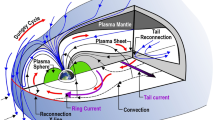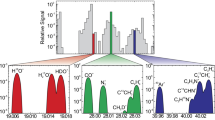Abstract
Aura, the last of the large EOS observatories, was launched on July~15, 2004. Aura is designed to make comprehensive stratospheric and tropospheric composition measurements from its four instruments, HIRDLS, MLS, OMI and TES. These four instruments work in synergy to provide data on ozone trends, air quality and climate change. The instruments observe in the nadir and limb and provide the best horizontal and vertical resolution ever achieved from space. After over one year in orbit the instruments are nearly operational and providing data to the scientific community. We summarize the mission, instruments, and initial results and give examples of how Aura will provide continuity to earlier chemistry missions.
Similar content being viewed by others
References
Anderson, J., Russell III, J. M., Solomon, S., and Deaver, L. E.: 2000, ‘Halogen Occultation Experiment confirmation of stratospheric chlorine decreases in accordance with the montreal protocol’, J. Geophys. Res. 105, 4483–4490.
Beer, R., Glavich, T. A., and Rider, D. M.: 2001, ‘Tropospheric emission spectrometer for the Earth Observing Systems Aura satellite’, Appl. Opt. 40, 2356–2367.
Gettelman, A., Holton, J., and Rosenlof, K.: 1997, ‘Mass fluxes of O3, CH4, N2O and CF2Cl2 in the lower stratosphere calculated from observational data’, J. Geophys. Res. 102, 19,149–19,159.
Gille, J., Barnett, J., Whitney, J., Dials, M., Woodard, D., Lambert, A., and Mankin, W.: 2003, ‘The High Resolution Dynamics Limb Sounder (HIRDLS) Experiment on Aura’, Proc. SPIE 5152, 162–171.
Glavich, T. and Beer, R.: 1991, ‘Tropospheric Emission Spectrometer for the Earth Observing System’, in: Infrared Technology XVII, Proc. SPIE 1540, 148–159.
Guicherit, R. and Roemer, M.: 2000, ‘Tropospheric ozone trends’, Chemosphere Global Change Sci. 2, 167–183.
Hauglustaine, D., et al.: 1998, ‘MOZART, a global chemical transport model for ozone and related chemical tracers 2. Model results and evaluation’, J. Geophys. Res. 103, 28,291–28,335.
Houghton, J., et al.: 2001, ‘Climate Change 2001: The Scientific Basis, IPCC, Intergovermental Panel on Climate Change’, Cambridge University Press, Cambridge, England, 944 pp.
IPCC: 2005, ‘Safeguarding the ozone layer and the global climate system: Issues related to the hydrofluorocarbons and perfluorocarbons, Summary for Policy Makers’, IPCC/TEAP Special Report, WMO/UNEP.
Levelt, P. F., Hilsenrath, E., Leppelmeier, G. W., van den Oord, G. H. J., Bhartia, P. K., Tamminen, J., de Haan, J. F., Veefkind, J. P., and Leppelmeier, G. W.: 2006, ‘Science objectives of the ozone monitoring instrument’, IEEE Transactions on Geoscience and Remote Sensing, 44, pp. 1199–1208, May 2006.
Logan, J. A.: 1985, ‘Tropospheric ozone — seasonal behavior, trends, and anthropogenic influence’, J. Geophys. Res. 90, 10,463–10,482.
Mote, P., et al.: 1996, ‘An atmospheric tape recorder: The imprint of tropical tropopause temperatures on stratospheric water vapor’, J. Geophys. Res. 101, 3989–4006.
Newman, P. A., Gleason, J. F., McPeters, R. D., and Stolarski, R. S.: 1997, ‘Anomalously low ozone over the Arctic’, Geophys. Res. Lett. 24, 2689–2692.
Read, W., et al.: 1995, ‘Upper tropospheric water vapor from UARS MLS’, Bull. Amer. Met. Soc. 76, 2381–2389.
Sandor, B. J., et al.: 1998, ‘Seasonal behavior of tropical to mid-latitude upper tropospheric water vapor from UARS MLS’, J. Geophys. Res. 103, 25,935–25,947.
Schoeberl, M. R., et al.: 2004, ‘Earth Observing Systems Benefit Atmospheric Research’, AGU EOS 85, 177–178.
Solomon, S.: 1999, ‘Stratospheric ozone depletion: A review of concepts and history’, Rev. Geophys. 37, 275–316.
Waters, J. W., et al.: 1993, ‘Stratospheric ClO and Ozone from the Microwave Limb Sounder on the Upper Atmosphere Research Satellite’, Nature 362, 597–602.
Waters, J. W., et al.: 1999, ‘The UARS and EOS microwave limb sounder (MLS) Experiments’, J. Atmos. Sci. 56, 194–218.
Waters, J. W., et al.: 2005, ‘The Earth Observing System Microwave Limb Sounder (EOS MLS) on the Aura Satellite’, IEEE, submitted to Transactions on Geoscience and Remote Sensing.
WMO (World Meteorological Organization): 2002, Scientific Assessment of Ozone Depletion: 2002, Global Ozone Research and Monitoring Project–Report No. 47, WMO/UNEP, Geneva, 498 pp.
Author information
Authors and Affiliations
Corresponding author
Rights and permissions
About this article
Cite this article
Hilsenrath, E., Schoeberl, M.R., Douglass, A.R. et al. Early Data from Aura and Continuity from Uars and Toms. Space Sci Rev 125, 417–430 (2006). https://doi.org/10.1007/s11214-006-9074-1
Received:
Accepted:
Published:
Issue Date:
DOI: https://doi.org/10.1007/s11214-006-9074-1




